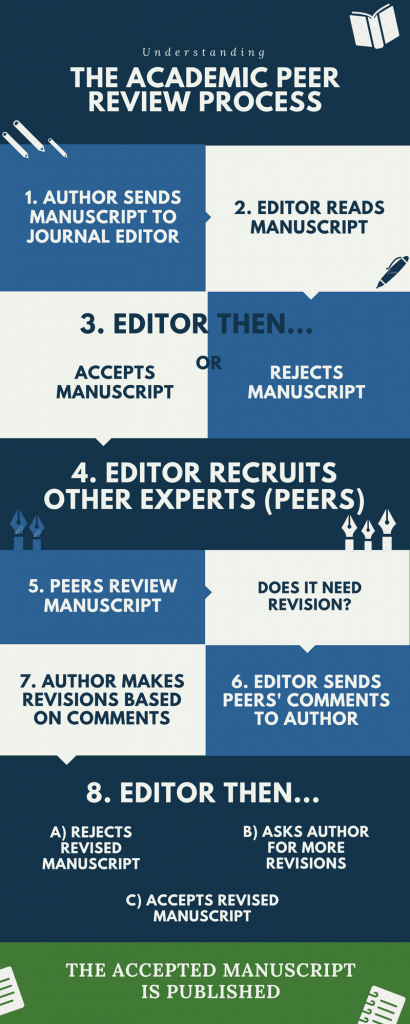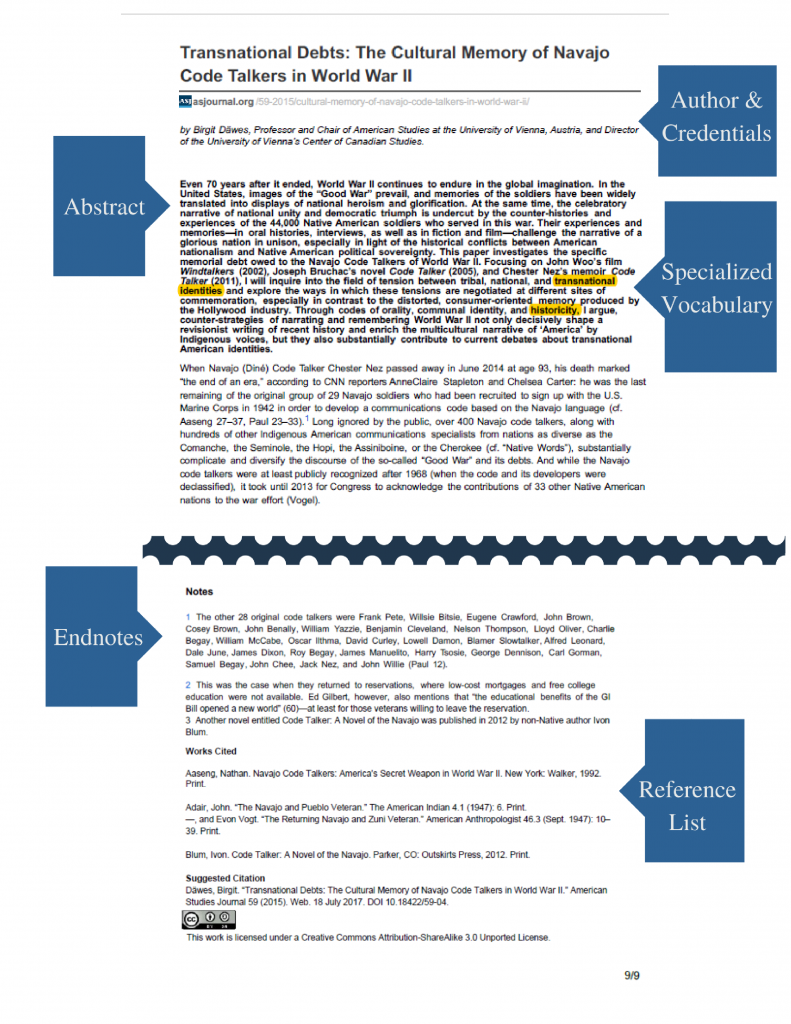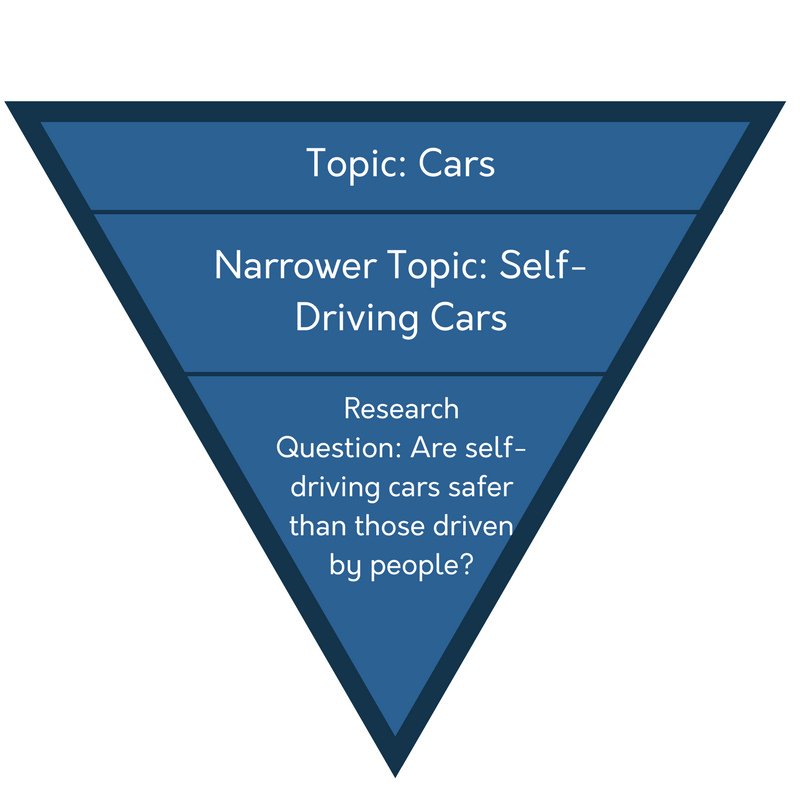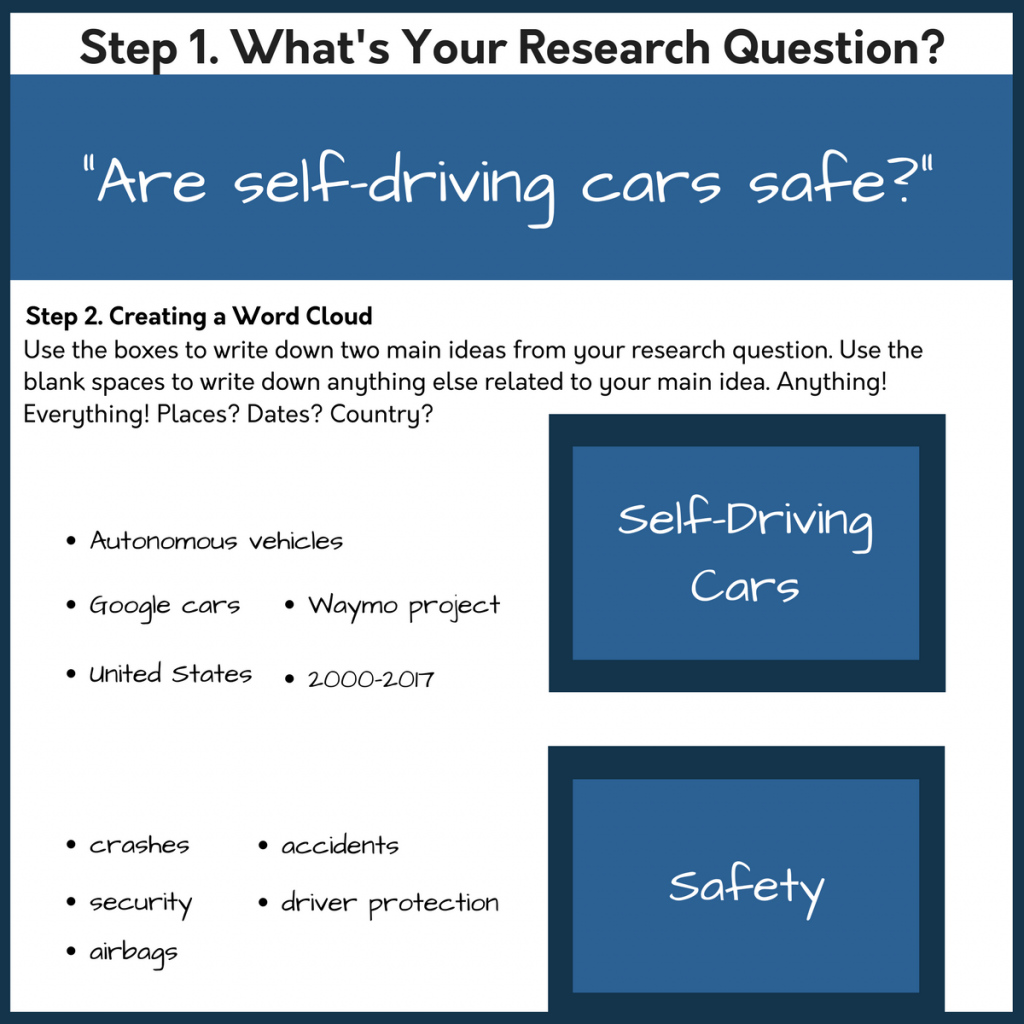2 Chapter 6 – Finding and Using Outside Sources
Katelyn Burton
Many college courses require students to locate and use secondary sources in a research paper. Educators assign research papers because they require you to find your own sources, confront conflicting evidence, and blend diverse information and ideas—all skills required in any professional leadership role. Some research papers also allow students to pursue their own topic of interest. In this section, we will answer the following questions:
1. What are the different types of sources?
2. What makes a source scholarly or academic?
3. How can I create a research strategy?
4. Where can I find credible sources for my paper?
1. What are the different types of sources?
Why is it that even the most informative Wikipedia articles are still often considered illegitimate? What are good sources to use instead? Above all, follow your professor’s guidelines for choosing sources. He or she may have requirements for a certain number of articles, books, or websites you should include in your paper. Be sure to familiarize yourself with your professor’s requirements.
The table below summarizes types of secondary sources in four tiers. All sources have their legitimate uses, but the top-tier ones are considered the most credible for academic work.
Figure 6.1 Source Type Table
|
Tier |
Type |
Content |
Uses |
How to find them |
|
1 |
Rigorous research and analysis |
Provide strong evidence for claims and references to other high-quality sources |
Academic article databases from the library’s website |
|
|
2 |
Reports, articles, and books from credible non-academic sources |
Well researched and even-handed descriptions of an event or state of the world |
Initial research on events or trends not yet analyzed in the academic literature; may reference important Tier 1 sources |
Websites of relevant government/nonprofit agencies or academic article databases from the library’s website |
|
3 |
Simple reporting of events, research findings, or policy changes |
Often point to useful Tier 2 or Tier 1 sources, may provide a factoid or two not found anywhere else |
Strategic Google searches or article databases including newspapers and magazines |
|
|
4 |
Mostly opinion, varying in thoughtfulness and credibility |
May represent a particular position within a debate; more often provide keywords and clues about higher quality sources |
Non-specific Google searches |
|
Tier 1: Peer-reviewed academic publications
Sources from the mainstream academic literature include books and scholarly articles. Academic books generally fall into three categories: (1) textbooks written with students in mind, (2) academic books which give an extended report on a large research project, and (3) edited volumes in which each chapter is authored by different people.
Scholarly articles appear in academic journals, which are published multiple times a year to share the latest research findings with scholars in the field. They’re usually sponsored by an academic society. To be published, these articles and books had to earn favorable anonymous evaluations by qualified scholars. Who are the experts writing, reviewing, and editing these scholarly publications? Your professors. We describe this process below. Learning how to read and use these sources is a fundamental part of being a college student.
Tier 2: Reports, articles, and books from credible non-academic sources
Some events and trends are too recent to appear in Tier 1 sources. Also, Tier 1 sources tend to be highly specific, and sometimes you need a more general perspective on a topic. Thus, Tier 2 sources can provide quality information that is more accessible to non-academics. There are three main categories.
First, official reports from government agencies or major international institutions like the World Bank or the United Nations; these institutions generally have research departments staffed with qualified experts who seek to provide rigorous, even-handed information to decision-makers.
Second, feature articles from major newspapers and magazines like The New York Times, Wall Street Journal, London Times, or The Economist are based on original reporting by experienced journalists (not press releases) and are typically 1500+ words in length.
Third, there are some great books from non-academic presses that cite their sources; they’re often written by journalists. All three of these sources are generally well researched descriptions of an event or state of the world, undertaken by credentialed experts who generally seek to be even-handed. It is still up to you to judge their credibility. Your instructors, librarians, or writing center consultants can advise you on which sources in this category have the most credibility.
Tier 3. Short pieces from periodicals or credible websites
A step below the well-developed reports and feature articles that make up Tier 2 are the short tidbits that one finds in newspapers and magazines or credible websites. How short is a short news article? Usually, they’re just a couple paragraphs or less, and they’re often reporting on just one thing: an event, an interesting research finding, or a policy change. They don’t take extensive research and analysis to write, and many just summarize a press release written and distributed by an organization or business. They may describe corporate mergers, newly discovered diet-health links, or important school-funding legislation.
You may want to cite Tier 3 sources in your paper if they provide an important factoid or two that isn’t provided by a higher-tier piece, but if the Tier 3 article describes a particular study or academic expert, your best bet is to find the journal article or book it is reporting on and use that Tier 1 source instead. Sometimes you can find the original journal article by putting the author’s name into a library database.
What counts as a credible website in this tier? You may need some guidance from instructors or librarians, but you can learn a lot by examining the person or organization providing the information (look for an “About” link on the website). For example, if the organization is clearly agenda-driven or not up-front about its aims and/or funding sources, then it definitely isn’t a source you want to cite as a neutral authority. Also look for signs of expertise. A tidbit about a medical research finding written by someone with a science background carries more weight than the same topic written by a policy analyst. These sources are sometimes uncertain, which is all the more reason to follow the trail to a Tier 1 or Tier 2 source whenever possible. The better the source, the more supported your paper will be.
Tip
It doesn’t matter how well supported or well written your paper is if you don’t cite your sources! A citing mistake or a failure to cite could lead to a failing grade on the paper or in the class. For more information about citations, see Chapter 7, “How and Why to Cite.”
Tier 4. Agenda-driven or pieces from unknown sources
This tier is essentially everything else. These types of sources—especially Wikipedia—can be helpful in identifying interesting topics, positions within a debate, keywords to search, and, sometimes, higher-tier sources on the topic. They often play a critically important role in the early part of the research process, but they generally aren’t (and shouldn’t be) cited in the final paper.
Exercise 1
Based on what you already know or what you can find from Tier 4 sources like Wikipedia, start a list of the people, organizations, sources, and keywords that seem most relevant to your topic. You may need this background information when you start searching for more scholarly sources later on.
Tip
Try to locate a mixture of different source types for your assignments. Some of your sources can be more popular, like Tier 3 websites or encyclopedia articles, but you should also try to find at least a few Tier 1 or Tier 2 articles from journals or reputable magazines/newspapers.
Key Takeaways
- There are several different categories of academic and popular sources. Scholarly sources are usually required in academic papers.
- It’s important to understand your professor’s requirements and look for sources that fill those requirements. Also, try to find a variety of different source types to help you fully understand your topic.
2. What makes a source scholarly or academic?
Most of the Tier 1 sources available are academic articles, also called scholarly articles, scholarly papers, journal articles, academic papers, or peer-reviewed articles. They all mean the same thing: a paper published in an academic journal after being scrutinized anonymously and judged to be sound by other experts in the subfield. Academic articles are essentially reports that scholars write to their peers—present and future—about what they’ve done in their research, what they’ve found, and why they think it’s important. Scholarly journals and books from academic presses use a peer-review process to decide which articles merit publication. The whole process, outlined below, can easily take a year or more!
Figure 6.2 Understanding the Academic Peer Review Process

When you are trying to determine if a source is scholarly, look for the following characteristics:
- Structure: The full text article often begins with an abstract or summary containing the main points of the article. It may also be broken down into sections like “Methods,” “Results,” and “Discussion.”
- Authors: Authors’ names are listed with credentials/degrees and places of employment, which are often universities or research institutions.The authors are experts in the field.
- Audience: The article uses advanced vocabulary or specialized language intended for other scholars in the field, not for the average reader.
- Length: Scholarly articles are often, but not always, longer than the popular articles found in general interest magazines like Time, Newsweek, National Geographic, etc. Articles are longer because it takes more content to explore topics in depth.
- Bibliography or Reference List: Scholarly articles include footnotes, endnotes or parenthetical in-text notes referring to items in a bibliography or reference list. Bibliographies are important to find the original source of an idea or quotation.
Figure 6.3 Example Scholarly Source

Writing at Work
Finding high-quality, credible research doesn’t stop after college. Citing excellent sources in professional presentations and publications will impress your boss, strengthen your arguments, and improve your credibility.
Key Takeaways
- Academic sources follow a rigorous process called peer-review. Significant time and effort goes into ensuring that scholarly journal articles are high-quality and credible.
- Skim a source and look for elements like a defined structure, author credentials, advanced language, and a bibliography. If these elements are included, the source is likely academic or scholarly.
3. How can I create a research strategy?
Now that you know what to look for, how should you go about finding academic sources? Having a plan in place before you start searching will lead you to the best sources.
Research Questions
Many students want to start searching using a broad topic or even their specific thesis statement. If you start with too broad of a topic, your search results list will overwhelm you. Imagine having to sort through thousands of sources to try to find ones to use in your paper. That’s what happens when your topic is too broad; your information will also be too broad. Starting with your thesis statement usually means you have already formed an opinion about the topic. What happens if the research doesn’t agree with your thesis? Instead of closing yourself off to one side of the story, it’s better to develop a research question that you would like the research to help you answer about your topic.
Steps for Developing a Research Question
The steps for developing a research question, listed below, help you organize your thoughts.
Step 1: Pick a topic (or consider the one assigned to you).
Step 2: Write a narrower/smaller topic that is related to the first.
Step 3: List some potential questions that could logically be asked in relation to the narrow topic.
Step 4: Pick the question in which you are most interested.
Step 5: Modify that question as needed so that it is more focused.
Here’s an example:
Figure 6.4 Developing a Research Question

Keywords & Search Terms
Starting with a research question helps you figure out precisely what you’re looking for. Next, you’ll need the most effective set of search terms – starting from main concepts and then identifying related terms. These keywords will become your search terms, and you’ll use them in library databases to find sources.
Identify the keywords in your research question by selecting nouns important to the meaning of your question and leaving out words that don’t help the search, such as adjectives, adverbs, prepositions and, usually, verbs. Nouns that you would use to tag your research question so you could find it later are likely to be its main concepts.
Example: How are birds affected by wind turbines?
The keywords are birds and wind turbines. Avoid terms like affect and effect as search terms, even when you’re looking for studies that report effects or effectiveness.These terms are common and contain many synonyms, so including them as search terms can limit your results.
Example: What lesson plans are available for teaching fractions?
The keywords are lesson plans and fractions. Stick to what’s necessary. For instance, don’t include: children—nothing in the research question suggests the lesson plans are for children; teaching—teaching isn’t necessary because lesson plans imply teaching; available—available is not necessary.
Keywords can improve your searching in all different kinds of databases and search engines. Try using keywords instead of entire sentences when you search Google and see how your search results improve.
For each keyword, list alternative terms, including synonyms, singular and plural forms of the words, and words that have other associations with the main concept. Sometimes synonyms, plurals, and singulars aren’t enough. Also consider associations with other words and concepts. For instance, it might help, when looking for information on the common cold, to include the term virus—because a type of virus causes the common cold.
Here’s an example of keywords & synonyms for our previous research question arranged in a graphic organizer called a Word Cloud:
Figure 6.5 What’s Your Research Question?

Once you have keywords and alternate terms, you are prepared to start searching for sources in library search engines called databases.
Exercise 2
Using the example shown above, create a Word Cloud for your research question. Think of at least five keywords and alternate terms you might use for searching. If your class had a library session, you will find a copy of the Word Cloud worksheet on your ENG 111 InfoGuide (http://infoguides.virginiawestern.edu/eng111) .
Key Takeaways
- It’s a good idea to begin the research process with a question you’d like to answer, instead of a broad topic or a thesis statement.
- Creating a research strategy and finding keywords and alternate terms for your topic can help you locate sources more effectively.
- Creating a Word Cloud to organize your thoughts makes searching for sources faster and easier.
4. Where can I find credible sources for my paper?
The college library subscribes to databases (search engines) for credible, academic sources. Some are general purpose databases that include the most prominent journals in many disciplines, and some are specific to a particular discipline. Brown Library’s website (https://tinyurl.com/y9yu5pmn) includes a database list containing over one hundred search engines, organized by subject area.
Sometimes the online database list is overwhelming for students. Please remember, you can always seek advice from librarians on the best databases for your topic. Librarians have also created InfoGuides (http://infoguides.virginiawestern.edu/), which contain a list of databases and other credible resources for different programs and courses offered at VWCC. Your English 111 InfoGuide (http://infoguides.virginiawestern.edu/eng111) is the best place to start your research for this class. View the “Finding Articles” tab to see a list of databases that may work for your topic.
Exercise 3
From the list of databases in the English 111 InfoGuide (http://infoguides.virginiawestern.edu/eng111) , choose at least two that you might want to search. Why did you choose those databases for your topic?
When you click on a link and open up a database, you will see a search box or several search boxes. Try typing some of your keywords/search terms into the search box. If you don’t see the type or number of results you want, try some of your other alternate terms. The main point is to keep trying! Sometimes you need to change your search terms or try searching in a different database to find new or different results.
Tip
If you can’t find the sources you need, visit the Reference Desk or set up an appointment for one-on-one help from a librarian. You can find the library’s hours and contact information on the Brown Library Homepage (https://tinyurl.com/y9yu5pmn).
Key Takeaways
- Academic libraries subscribe to special search engines for scholarly sources called databases.
- Librarians can help you find and use the best databases for your subject or topic.
Additional Links
English 111 InfoGuide, (http://infoguides.virginiawestern.edu/eng111) Brown Library
Scholarly Source Annotation, (http://libguides.radford.edu/scholarly) Radford University
CC-Licensed Content, Shared Previously
Choosing & Using Sources: A Guide to Academic Research. Cheryl Lowry, ed., CC-BY.
Writing in College: From Competence to Excellence. Amy Guptill, CC BY-NC-SA.
Image Credits
Figure 6.1 “Source Type Table,” Writing in College: From Competence to Excellence, by Amy Guptill, Open SUNY, CC-BY-SA-NC.
Figure 6.2 “Understanding the Academic Peer Review Process,” Kalyca Schultz, Virginia Western Community College, CC-0.
Figure 6.3 “Example Scholarly Source”, Kalyca Schultz, Virginia Western Community College, CC-BY-SA, derivative image from “Transnational Debts: The Cultural Memory of Navajo Code Talkers in World War II” in American Studies Journal, by Birgit Dawes, American Studies Journal, CC-BY-SA.
Figure 6.4 “Developing a Research Question,” Kalyca Schultz, Virginia Western Community College, CC-0.
Figure 6.5 “What’s Your Research Question?,” Kalyca Schultz, Virginia Western Community College, CC-0.

